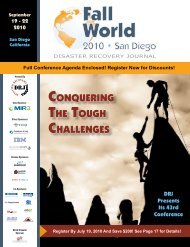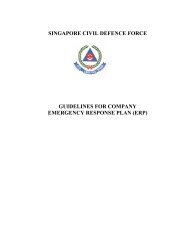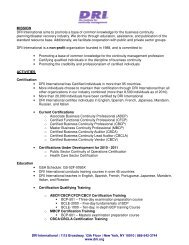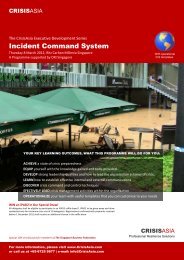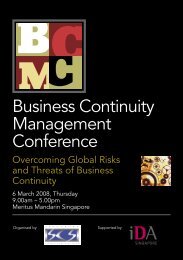Framework for Voluntary Preparedness - Association of Contingency ...
Framework for Voluntary Preparedness - Association of Contingency ...
Framework for Voluntary Preparedness - Association of Contingency ...
Create successful ePaper yourself
Turn your PDF publications into a flip-book with our unique Google optimized e-Paper software.
<strong>Framework</strong> For <strong>Voluntary</strong> <strong>Preparedness</strong><br />
A similar approach <strong>for</strong> such businesses would significantly enhance preparedness per<strong>for</strong>mance <strong>of</strong><br />
these businesses without imposing the financial burden <strong>of</strong> <strong>for</strong>mal standard implementation and<br />
certification.<br />
PROPOSED VERIFICATION MECHANISM: First Party Self-Declaration Against Core Element Checklist<br />
EVIDENCE OF PREPAREDNESS: BUSINESS READINESS DECAL<br />
MEETING THE CHALLENGES SUMMARY<br />
The intent <strong>of</strong> Title IX <strong>of</strong> PL 110-53 is to enhance private sector preparedness. For this to be<br />
accomplished, private sector organizations need to be given the freedom and flexibility to address<br />
the core issues <strong>of</strong> preparedness that are appropriate to their existing management models, mission,<br />
and size <strong>of</strong> organization. From this discussion, it is clear that regulated industry sectors, unregulated<br />
industry sectors, small to medium businesses involved in the supply chain with other businesses and<br />
stand-alone small businesses face the challenge <strong>of</strong> enhanced preparedness per<strong>for</strong>mance from<br />
different economic realities. The approach to achieve this goal may be through compliance with<br />
regulations, implementations <strong>of</strong> standards, or adopting core elements <strong>of</strong> standards in simplified<br />
management models. Acceptance and viability <strong>of</strong> any approach will be dependent on business<br />
decisions consistent with the mission and economic realities <strong>of</strong> the organization. Obviously, building on<br />
existing management models and avoidance <strong>of</strong> duplication are at the heart <strong>of</strong> any successful<br />
preparedness program. There<strong>for</strong>e, organizations that are in con<strong>for</strong>mity with existing regulations,<br />
standards, guidelines or industry best practices that address the core elements <strong>of</strong> preparedness should<br />
be recognized as having achieved the intent <strong>of</strong> Title IX <strong>of</strong> PL 110-53, and should be credited <strong>for</strong><br />
existing practices to the extent such practices address the identified core elements. Certification to a<br />
specific preparedness standard may be adopted voluntarily by an organization as a competitive<br />
differentiator.<br />
CONCLUSIONS<br />
Any <strong>of</strong> the three approaches (enterprise risk management, standards or regulatory approaches) can<br />
be used to meet the intent <strong>of</strong> Title IX <strong>of</strong> PL 110-53 <strong>for</strong> improved private sector preparedness<br />
per<strong>for</strong>mance. As has been seen in environmental management, these three approaches can be used<br />
together as complementary tools if this fits within the management scheme <strong>of</strong> the organization.<br />
Also, as clearly demonstrated by environmental management, considerations must be made <strong>for</strong> the<br />
economic constraints <strong>of</strong> small business. Improved preparedness per<strong>for</strong>mance and all the core elements<br />
above can be addressed by less <strong>for</strong>mal approaches to meet the intent <strong>of</strong> Title IX <strong>of</strong> PL 110-53.<br />
It is important <strong>for</strong> the DHS to recognize that multiple approaches comply with the spirit <strong>of</strong> Title IX <strong>of</strong> PL<br />
110-53. There<strong>for</strong>e, greater resiliency success will be achieved if businesses are given the freedom<br />
and flexibility to determine how they will improve preparedness in a way that best fits their<br />
respective business models. Any process or approach that addresses the core elements addressed<br />
above is sufficient to improve preparedness per<strong>for</strong>mance without the need <strong>for</strong> duplication <strong>of</strong> ef<strong>for</strong>ts<br />
and unnecessary financial burden to the private sector.<br />
Page 9



